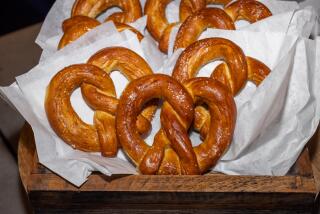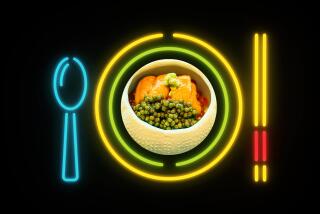Cruises Trim Fat From Their Sails
- Share via
Suggest a cruise vacation to a fitness buff, and you’re apt to get a negative response. Sure, most lines have added aerobics classes and exercise equipment to their ships, and shore excursions now include active options such as white-water rafting, diving and mountain biking. But what about the food? A dozen feedings a day, a parade of killer desserts and that ominous midnight buffet . . . as one quipster put it: “Afloat you bloat.”
Not in the ‘90s.
Responding to demand from health-conscious repeat passengers, and trying to attract younger vacationers, the cruise industry has lightened up its menus while beefing up athletic activities. Salad bars have become standard luncheon fare on the buffet deck. Vegetarian entrees and simply broiled chicken and fish dishes have joined the mix of red meats in the main dining room. More menus include appetizers, entrees and desserts low in calories, sodium and cholesterol. Even the midnight buffet has shaped up, with fresh fruits, light pasta dishes and other guilt-free items sharing space with beef stroganoff and crepes suzette.
“In the last few years, I’d say nearly 100% of cruise ships have changed their meals and menus to accommodate passengers who want lighter, healthier fare,” said Jim Godsman, president of Cruise Lines International Assn., an industry group representing 32 cruise lines. Jennifer de la Cruz, a spokeswoman for Carnival Cruises, said a recent study by her company’s food and beverage department found a 300% increase in consumption of vegetarian entrees over the past few years, a 20% increase in seafood and poultry orders and a 20% decrease in orders of red meat.
Julie Benson of Princess Cruises said drinking habits have changed, too. “You used to see people at the bar and pool ordering bottles of liquor to take to their cabins. Now they’re requesting bottles of Evian and a few limes,” she said.
Those who want to eat and drink to the hilt can still do so on most ships--and many passengers still see huge amounts of rich goodies served throughout the day as an essential part of the cruise experience. But cruise lines report that more passengers are after quality rather than quantity and don’t want to be confronted with food-laden tables every time they turn a corner.
“We actually had people thank us for not having a midnight buffet,” said Robin Lindsay, a vice president with 2-year-old Diamond Cruise, which operates the Radisson Diamond. The Diamond’s dinner menu includes such healthful choices as vegetarian entrees, grilled fish and low-cal pasta.
Ann Burguieres of Regency Cruises said orders of diet-conscious items soared when her company created a separate “Lean and Light” dinner menu, which lists calorie, sodium and cholesterol information for each course. The line also has a special “Lean and Light” buffet at lunch, with salads, fresh fruits and high-fiber granola and breads.
The degree of food consciousness-raising on board varies from one cruise line to another, ranging from flagging a few low-fat items on the dinner menu to setting aside special dining rooms devoted exclusively to healthful eating.
The most ambitious program--at a price--debuted in May aboard Cunard’s Queen Elizabeth II. Passengers on transatlantic crossings can book a $599 “Spa World Health and Fitness Package” that not only entitles them to the run of the ship’s 6,000 square feet of exercise facilities, abundant spa treatments and lectures on nutrition and stress reduction, but also gets them a seat in a special dining room where only healthful low-calorie, low-sodium and low-fat food is served.
The package can only be purchased by passengers booking first-class “Columbia-grade” cabins, and once you commit to the Spa World dining room you can’t switch back and forth between it and the regular restaurant. Traveling companions who want to dine with package participants in the Spa World restaurant but don’t want spa food can order off the menu of the adjacent Columbia Restaurant.
Passengers who don’t book the Spa World package can still eat healthfully by referring to specially marked menu items in the ship’s other dining rooms.
“Not everyone wants to go the whole nine yards,” said Cunard’s Priscilla Hoye. “But a lot of our younger passengers really love the opportunity to focus on health and fitness afloat.” *
Following are a selection of other cruise lines with options for healthful eating. (The lines also have extensive on-board fitness facilities.) Beware, however. Just because a ship caters to healthful eating doesn’t mean you’re off the hook willpower-wise. Norwegian Cruise Line, which offers lean dinner entrees, lunch-time salad bars and even fresh-fruit platters at its midnight spread, recently introduced a new buffet to tempt even the most intrepid dieter--an afternoon Chocaholics’ Bar.
* Carnival Cruise Lines. Spa cuisine is identified on menus, and extensive salad bars with low-cal dressings are offered at lunch on all ships. The line has added vegetarian entrees, and ship-board chefs have been experimenting with fresh herb and spice seasonings in lieu of heavy oil- and cream-based sauces.
* Crystal Cruises. Chef’s selections at lunch and dinner recommend healthful full-course meals. In addition, guests can order an abundance of items on and off the menu at every meal, prepared as they like. The deck buffet at lunch has an extensive salad bar, and the fitness program’s exercise physiologists can counsel passengers on how to eat healthfully on board. * Holland America Line. A full-service juice bar attached to the huge Ocean Spa on the Statendam, Maasdam and new Ryndam offers about 10 fresh fruit and vegetable juices, plus a variety of bottled waters. All menus flag heart-healthful selections.
* Princess Cruises. Light cuisine choices are offered at all meals, as well as extensive salad-bar selections at lunch. The midnight buffet is more of a snack than a spread. On-board fitness program instructors can give tips on healthful eating, as well.
* Royal Caribbean Cruise Line. The line’s ShipShape health-and-exercise program includes specially noted ShipShape menu items for each dinner course. There’s also a separate vegetarian lunch and dinner menu, which, though not made up entirely of low-cal items, always includes a sampling of healthful choices. The shipboard menus were created in consultation with an in-house dietitian formerly with California’s Pritikin Longevity Center.
* Royal Cruise Line. All cabins contain a 14-page booklet titled “Dine to Your Heart’s Content,” which gives tips on healthful eating on board, based on American Heart Assn. guidelines. The publication provides fat, salt and cholesterol information for selected foods and sample menu plans for daily dining afloat--which are reinforced by flagged items on the restaurant menu. A lecture program called “New Beginnings” brings on board experts in nutrition, fitness, stress and other quality-of-life issues. They give scheduled talks as well as informal one-on-one consultations.
* Windstar Cruises. The line recently retained Joachim Splichal, chef/proprietor of two of Los Angeles’ toniest restaurants: Patina and Pinot Bistro in Studio City, to create 180 new California-French menu items, designed to be gourmet-light. The menu relies heavily on fresh market produce from ports of call, and recipes often use spices in lieu of heavy sauces. No midnight buffet.
* World Explorer Cruises. The line offers a wide selection of vegetarian entrees and salad choices, and no MSG is used in food preparation. Low-cal and low-sodium foods are flagged on the menu. The midnight buffet is a light snack. On-board Passport to Fitness program instructors help passengers devise a plan for exercise and healthful eating afloat.
More to Read
Sign up for The Wild
We’ll help you find the best places to hike, bike and run, as well as the perfect silent spots for meditation and yoga.
You may occasionally receive promotional content from the Los Angeles Times.






